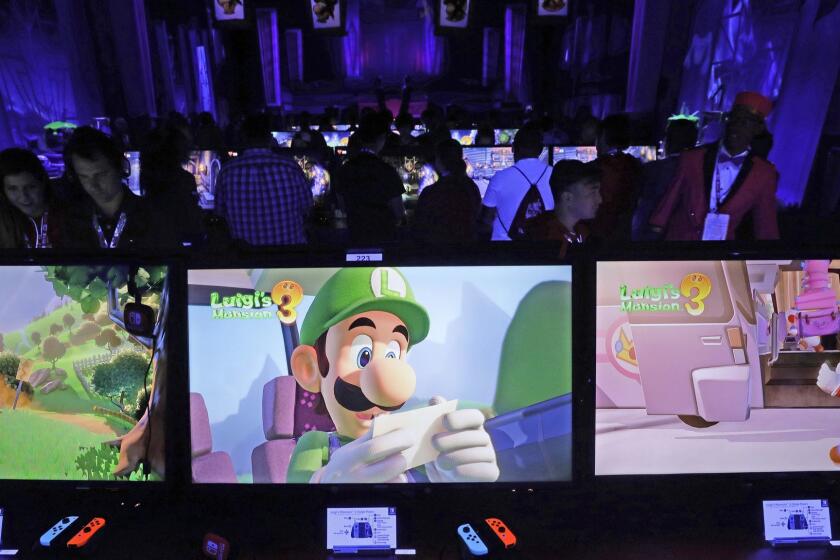Review: ‘Ring Fit Adventure’ is Nintendo’s bid to slay the fitness dragon
“Ring Fit Adventure” puts the focus on play rather than fitness goals. It reflects the mission of Nintendo’s late great Satoru Iwata, who said one of his goals was to reorient Nintendo to focus on health devices, playful tech.
- Share via
Early in “Ring Fit Adventure,” a talking, virtual Pilates-like ring tells you that your “glistening sweat” is beautiful. Your opinion of such a phrase — sorta cute, kinda funny or infuriating — might reflect how you will feel about Nintendo’s latest bid to enter the fitness and tech market.
I rolled my eyes yet ultimately kept playing. Partly because I fell out of a pretty strict fitness regiment the last two hectic months and partly because there was a dragon ahead. But not just any dragon. This is a body-building-obsessed, hyper-masculine hunk of dragon idiocy. At long last, here was an antagonist that I recognized and was eager to battle. I could see a teenaged version of this “Ring Fit Adventure” dragon — imagine a distant cousin of Chernabog from “Fantasia’s” “Night on Bald Mountain” scene — coming up to my junior high locker to ask me how much I could “bench” before laughing in my face.
So run in place I will, holding my surprisingly comfortable and wonderfully adept tech-enhanced plastic ring in front of me. Said ring, which Nintendo calls a “Ring-Con,” is the main peripheral of “Ring Fit Adventure,” and it can not only measure your strength — exercises are essentially completed by pulling the ring in or out — but help you complete modified versions of the sorts of activities that you bought your unused sack resistance bands for. It can also measure your heart rate.
Mario has been Nintendo’s unlikely hero for more than 30 years — a plump plumber who dates outside his class and, as shown in the opening moments of one of the company’s upcoming adventures, won’t even carry his own luggage.
Combine the Ring-Con with a leg strap affixed to your thigh, each one holding one of the controllers of the Nintendo Switch, and “Ring Fit Adventure” turns out to be hiding a pretty potent little exercise machine under its fight-the-dragon adventure premise. The Ring-Con can be used with shoulders and thighs for myriad exercises to target various muscles outside of the main game. In one week with the $80 device, I’ve largely been using it, and it has forced me to work through some of the core-strengthening exercises my physical therapist thinks I’m doing every day.
While there are echos of Nintendo’s Wii Fit, an instant hit when it was unveiled in Japan in 2007 and the victim of stock shortages for months in the U.S. upon its 2008 release, that item is likely collecting dust in most closets these days. Still, there’s no denying the Wii Fit foretold a future where game-like elements would creep into all aspects of our life. Exercise has long been seen as a market for gamification, dating back to pricey, early exercise bikes that showed stationary users peddling along digital forest preserves to today’s Apple Watches, Fitbits and bounty of apps such as Noom, the latter of which essentially turns calorie counting into a game.
All of these devices hold aspirational qualities. At long last, they promise, technology will not only make exercise and staying in shape fun, it will be easy! Not really — if you’re not already in the large segment of the population that craves physical movement it’s unlikely an Apple Watch, a Fitbit, an app or “Ring Fit Adventure” will provide some magical answer to loving exercise. That’s fine, though. These devices needn’t be life-changers so much as different options to either help us get out of a routine or create a new one.
And “Ring Fit Adventure’s” main game works hard to become part of our daily life. It’s robust, for one. Nintendo says that if one spends between 30 minutes and one hour with the game every day it could take up to three months to complete. Probably longer, if, like me, you choose to mix and match your own exercises with custom routines or mini-games, such as one that has you stretching out or pressing in on the Ring-Con to smash robots. More fun and goofy is a pottery game, which combines squats and arm presses on the Ring-Con to shape and sculpt virtual clay. It can burn a few calories but also works as a party game.
The main quest of player-versus-bullying-dragon alternates running in place with a host of exercises. We uncover more as we move more deeply into the game, and while this is meant to encourage us to keep playing and learn different fitness routines, as someone who suffers from occasionally paralyzing sciatica I wanted significantly more exercises available at the start of the game.
Squats are great and all, but the level to which my lower back allows me to move is not necessarily always the level that will best a foe. To be fair, difficulty settings can be adjusted to allow for modified versions of exercises, and the Ring-Con and leg strap do a strong job of recognizing body movement and posture. But I’m a masochist and refuse to work out on anything but the higher levels and would thus prefer to choose from different movements rather than adjust the difficulty. While many games tie abilities or trinkets to advancement, this game design trick only works when the game is essentially teaching the player new abilities. In an instance in which we are the controller, more or less, chances are we know our own abilities better than any piece of tech.
Picture a future where the police are in the camp of the righteous. That’s Nintendo’s “Astral Chain.” And even in auto-pilot, you can save the world.
But I know the game has the exercises I want — they are all accessible outside of the adventure — so I’m willing to stick it out, as it’s just silly and fun enough to move through hills, bridges and ponds to stop this dragon from spreading his cult-like fitness beliefs throughout a fantasy universe where street fixtures are barbells. This world, while colorful and welcoming, is sort of akin to if your local gym had vomited all of its equipment throughout your neighborhood, and instead of half-broken scooters littering your sidewalks you saw weights — and purple monsters that sort of look like they have boxing gloves for hands. These are the dragon’s minions, and you defeat them by doing exercises. Simple ones, such as the aforementioned squats, or overhead presses to start, the latter accomplished by trying to squeeze the Ring-Con together.
“Ring Fit Adventure” won’t be the phenom that was “Wii Fit,” but that’s because the latter started this revolution, one in which today includes a wearables market that has exploded beyond fitness to include lifestyle accessories that promise to aid in sleep or relieve pain. Using tech to gamify our lives has become so commonplace that “Ring Fit Adventure’s” biggest challenge is simply standing out, and out of the box it gets one thing right: We never feel like we’re losing.
It’s OK to fail in “Super Mario Bros.,” because each death-causing challenge becomes something of a puzzle. It’s less OK to fail with an app or device that’s simply measuring our daily step count. Seeing how we fell short of 10,000 steps can quickly cause an antagonistic relationship: Doesn’t our phone know that today we had to work for 16 hours and couldn’t go for a walk? “Ring Fit Adventure,” on the other hand, is always encouraging, telling us our sweat that it can’t see is beautiful and encouraging us to stop working out for the day if our heartbeat indicated a strenuous session.
Nintendo game “Fire Emblem: Three Houses” is a genre-mashup designed to last well over 100 hours. It’s a commitment of time and, in its many searches for love, of the heart. Is it worth getting attached?
“Ring Fit Adventure” seems to reflect the mission of Nintendo’s late great Satoru Iwata, who died in 2015 at 55. Shortly before his death he said one of his goals was to reorient Nintendo to focus on health devices, playful tech that he said “improves people’s [quality of life] in enjoyable ways.” While no piece of tech can accurately engage in a conversation, at least not yet, I’m enjoying “Ring Fit Adventure” because it understands that the human is in charge and that goals are meant to broken or tweaked, sometimes by the hour. Stop, it says repeatedly, and go drink water. It even encourages players to turn it off and come back later and constantly asks you to change the difficulty settings.
I haven’t gotten to the end of the storyline — working out for 90 hours in a span of five days didn’t seem wise, even if it were possible — so I don’t know if the dragon is redeemed, although I imagine a lesson is learned. But what “Ring Fit Adventure” is telling us from the start is that those who proclaim that fitness is easy, whether it’s a macho dragon, a piece of tech or just the co-worker who bikes to work — aren’t who most of us should be listening to.
So it may be a talking, virtual ring that gets through to you, but that’s putting too much pressure on “Ring Fit Adventure.” Instead, with “Ring Fit Adventure” Nintendo has created a fitness game that puts the emphasis on play rather than ever-increasing goals.
"Ring Fit Adventure"
More to Read
The biggest entertainment stories
Get our big stories about Hollywood, film, television, music, arts, culture and more right in your inbox as soon as they publish.
You may occasionally receive promotional content from the Los Angeles Times.










